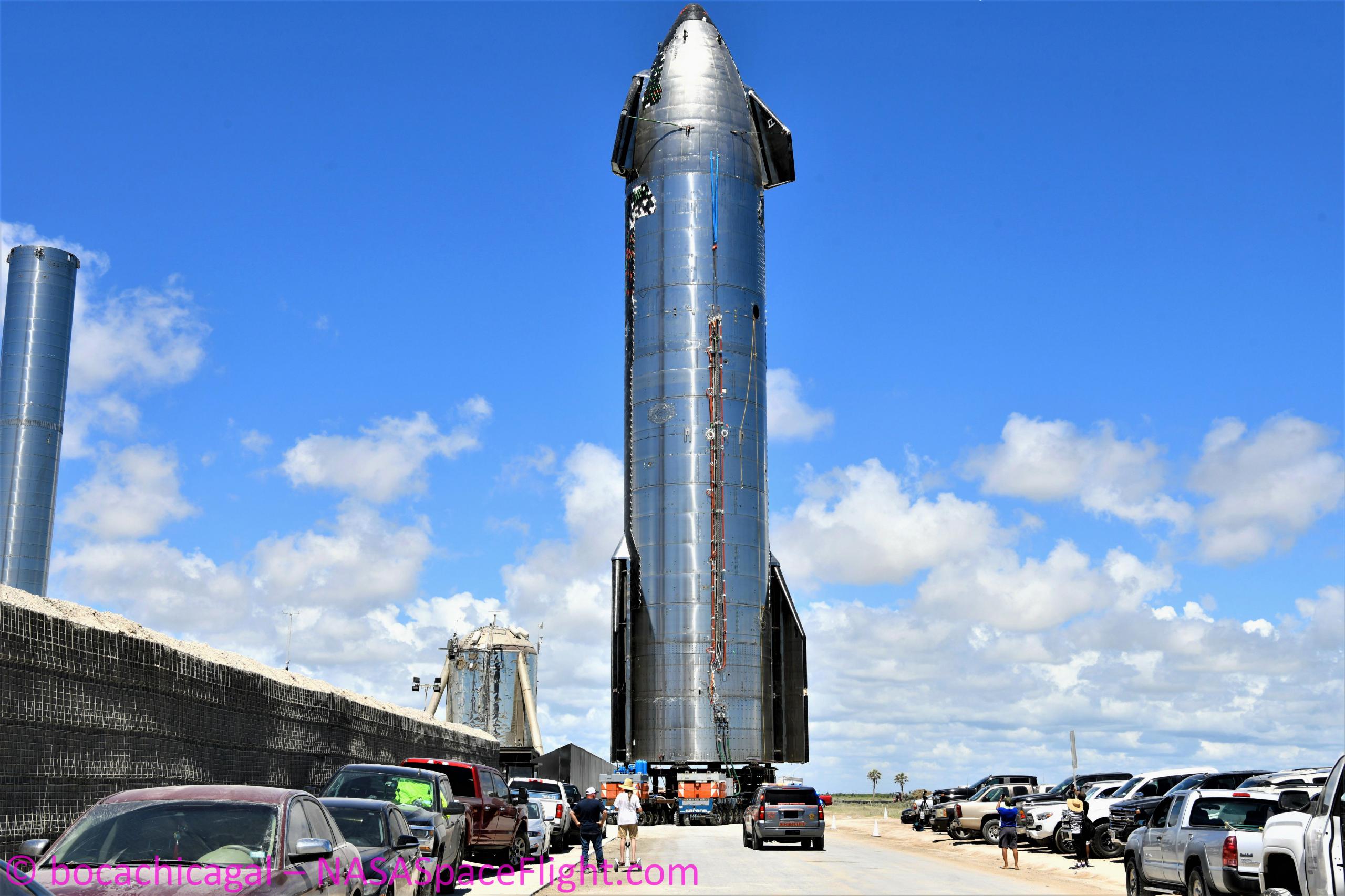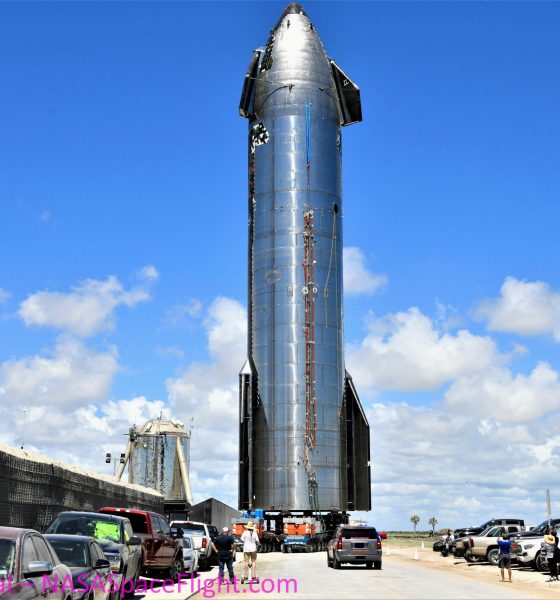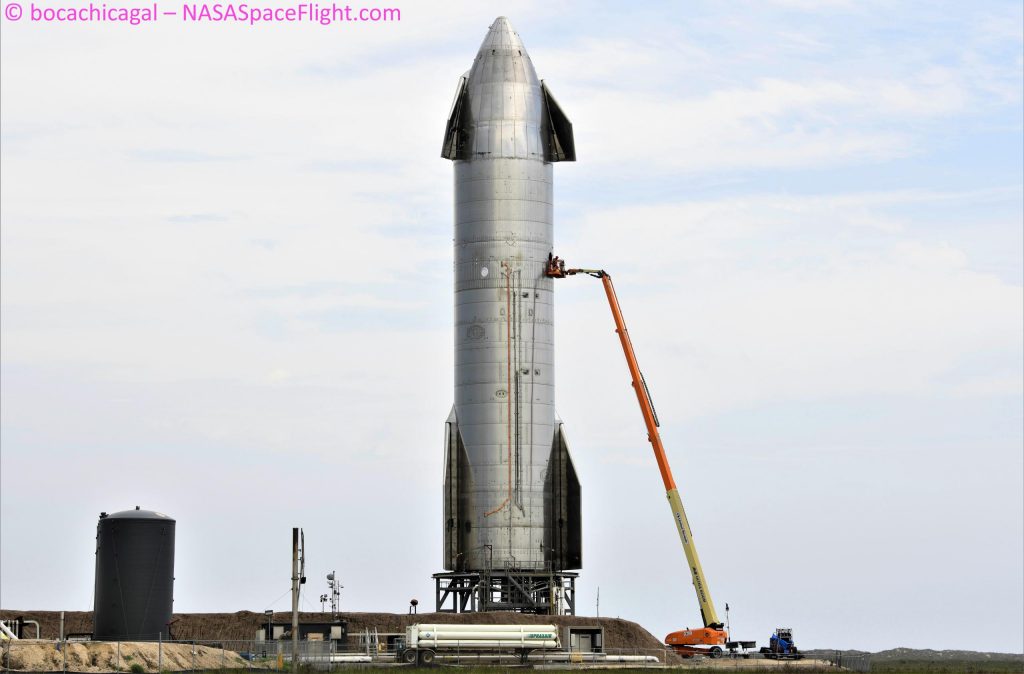

News
SpaceX’s first orbital Starship prototype prepares for proof tests
Several days after SpaceX’s first orbital-class Starship prototype took a second trip to a nearby launch site, the rocket is on its way to one of two suborbital launch mounts.
Once installed on the steel structure, Starship prototype 20 (S20) will finally be ready for – at minimum – two crucial tests: a cryogenic proof and static fire. According to highway closures filed by SpaceX late last week, the first of those tests could apparently begin as early as Thursday, August 19th, potentially setting Starship S20 up to attempt at least one major milestone next week.
On August 13th, SpaceX rolled Starship S20 back to the launch site a week after the rocket was sent to the pad to be briefly stacked on top of a Super Heavy booster – an event that appears to have been something like 50% photo opportunity, 50% test objective. Neither the booster or ship were fully complete at the time and both ultimately required at least another week or two of outfitting and plumbing to be ready for ground testing – let alone flight. Aspirationally, the same pair – Ship 20 and Booster 4 – could be the first to attempt a true orbital Starship launch sometime later this year.
Since its second rollout, Ship 20 has more or less stayed in one place as workers continuously swarmed about the rocket on boom and scissor lifts. Over the last four days, not much has visually changed save for the installation of a handful of heat shield tiles, but the focus clearly centered around the Starship’s ‘raceway’ – a clutch of plumbing and wiring that runs most of the length of the vehicle’s back. Virtually all rockets have them and Starship is no different with a raceway packed with avionics wire runs, plumbing for propellant loading, and smaller lines for pressurization and hydraulics.
While it’s not entirely clear what specific work has been done over the last few days or why it wasn’t done back at the build site, where CEO Elon Musk himself has said such tasks are more easily done, it’s clear that Starship S20 does have a more refined raceway than any ship before it. In recent days, SpaceX has also begun to install structural elements that strongly imply that S20 will be the first Starship to receive a raceway aerocover – not unlike those on Falcon boosters – to protect its external wiring and plumbing in flight.

Regardless, once Starship S20 is installed on one of SpaceX’s two suborbital launch mounts, the vehicle will most likely be prepared for a routine cryogenic proof test. To pass, Starship will need to survive significant thermal and mechanical stress as its tanks are filled with supercool liquid nitrogen and pressurized to at least 6 bar (~90 psi). At this point, a Starship prototype hasn’t failed a cryo proof in more than a year, so the test should be fairly routine.
Curiously, after spending weeks modifying Mount B with a series of hydraulic rams meant to simulate the thrust of Ship 20’s six Raptor engines during its cryo proof(s), SpaceX removed all of that extra hardware just prior to the Starship’s second rollout and now-imminent installation on said mount. Regardless of why, that decision likely means that Starship S20 will move directly to static fire testing once it passes cryo proofing. Given that Ship 20 appears to be on track to be the first Starship prototype of any kind to fire more than three Raptors at a time, that static fire campaign will likely be somewhat cautious, possibly beginning with just 1-3 engines and then moving to four, five, or straight to six.
SpaceX could also throw caution to the wind (not implausible as evidenced by the removal of Pad B’s unused thrust rams) and install and attempt to fire all six Raptors immediately after Ship 20 completes a cryo proof. Based on road closures filed by SpaceX, that testing could begin as early as 5pm to 11pm CDT on Thursday, August 19th. A backup window is also scheduled from 6am to 12pm CDT on August 20th.

Elon Musk
Elon Musk confirms xAI’s purchase of five 380 MW natural gas turbines
The deal, which was confirmed by Musk on X, highlights xAI’s effort to aggressively scale its operations.

xAI, Elon Musk’s artificial intelligence startup, has purchased five additional 380 MW natural gas turbines from South Korea’s Doosan Enerbility to power its growing supercomputer clusters.
The deal, which was confirmed by Musk on X, highlights xAI’s effort to aggressively scale its operations.
xAI’s turbine deal details
News of xAI’s new turbines was shared on social media platform X, with user @SemiAnalysis_ stating that the turbines were produced by South Korea’s Doosan Enerbility. As noted in an Asian Business Daily report, Doosan Enerbility announced last October that it signed a contract to supply two 380 MW gas turbines for a major U.S. tech company. Doosan later noted in December that it secured an order for three more 380 MW gas turbines.
As per the X user, the gas turbines would power an additional 600,000+ GB200 NVL72 equivalent size cluster. This should make xAI’s facilities among the largest in the world. In a reply, Elon Musk confirmed that xAI did purchase the turbines. “True,” Musk wrote in a post on X.
xAI’s ambitions
Recent reports have indicated that xAI closed an upsized $20 billion Series E funding round, exceeding the initial $15 billion target to fuel rapid infrastructure scaling and AI product development. The funding, as per the AI startup, “will accelerate our world-leading infrastructure buildout, enable the rapid development and deployment of transformative AI products.”
The company also teased the rollout of its upcoming frontier AI model. “Looking ahead, Grok 5 is currently in training, and we are focused on launching innovative new consumer and enterprise products that harness the power of Grok, Colossus, and 𝕏 to transform how we live, work, and play,” xAI wrote in a post on its website.
Elon Musk
Elon Musk’s xAI closes upsized $20B Series E funding round
xAI announced the investment round in a post on its official website.

xAI has closed an upsized $20 billion Series E funding round, exceeding the initial $15 billion target to fuel rapid infrastructure scaling and AI product development.
xAI announced the investment round in a post on its official website.
A $20 billion Series E round
As noted by the artificial intelligence startup in its post, the Series E funding round attracted a diverse group of investors, including Valor Equity Partners, Stepstone Group, Fidelity Management & Research Company, Qatar Investment Authority, MGX, and Baron Capital Group, among others.
Strategic partners NVIDIA and Cisco Investments also continued support for building the world’s largest GPU clusters.
As xAI stated, “This financing will accelerate our world-leading infrastructure buildout, enable the rapid development and deployment of transformative AI products reaching billions of users, and fuel groundbreaking research advancing xAI’s core mission: Understanding the Universe.”
xAI’s core mission
Th Series E funding builds on xAI’s previous rounds, powering Grok advancements and massive compute expansions like the Memphis supercluster. The upsized demand reflects growing recognition of xAI’s potential in frontier AI.
xAI also highlighted several of its breakthroughs in 2025, from the buildout of Colossus I and II, which ended with over 1 million H100 GPU equivalents, and the rollout of the Grok 4 Series, Grok Voice, and Grok Imagine, among others. The company also confirmed that work is already underway to train the flagship large language model’s next iteration, Grok 5.
“Looking ahead, Grok 5 is currently in training, and we are focused on launching innovative new consumer and enterprise products that harness the power of Grok, Colossus, and 𝕏 to transform how we live, work, and play,” xAI wrote.
Investor's Corner
Tesla gets price target bump, citing growing lead in self-driving

Tesla (NASDAQ: TSLA) stock received a price target update from Pierre Ferragu of Wall Street firm New Street Research, citing the company’s growing lead in self-driving and autonomy.
On Tuesday, Ferragu bumped his price target from $520 to $600, stating that the consensus from the Consumer Electronics Show in Las Vegas was that Tesla’s lead in autonomy has been sustained, is growing, and sits at a multiple-year lead over its competitors.
CES 2026 validates Tesla’s FSD strategy, but there’s a big lag for rivals: analyst
“The signal from Vegas is loud and clear,” the analyst writes. “The industry isn’t catching up to Tesla; it is actively validating Tesla’s strategy…just with a 12-year lag.”
The note shows that the company’s prowess in vehicle autonomy is being solidified by lagging competitors that claim to have the best method. The only problem is that Tesla’s Vision-based approach, which it adopted back in 2022 with the Model 3 and Model Y initially, has been proven to be more effective than competitors’ approach, which utilizes other technology, such as LiDAR and sensors.
Currently, Tesla shares are sitting at around $433, as the company’s stock price closed at $432.96 on Tuesday afternoon.
Ferragu’s consensus on Tesla shares echoes that of other Wall Street analysts who are bullish on the company’s stock and position within the AI, autonomy, and robotics sector.
Dan Ives of Wedbush wrote in a note in mid-December that he anticipates Tesla having a massive 2026, and could reach a $3 trillion valuation this year, especially with the “AI chapter” taking hold of the narrative at the company.
Ives also said that the big step in the right direction for Tesla will be initiating production of the Cybercab, as well as expanding on the Robotaxi program through the next 12 months:
“…as full-scale volume production begins with the autonomous and robotics roadmap…The company has started to test the all-important Cybercab in Austin over the past few weeks, which is an incremental step towards launching in 2026 with important volume production of Cybercabs starting in April/May, which remains the golden goose in unlocking TSLA’s AI valuation.”
Tesla analyst breaks down delivery report: ‘A step in the right direction’
Tesla has transitioned from an automaker to a full-fledged AI company, and its Robotaxi and Cybercab programs, fueled by the Full Self-Driving suite, are leading the charge moving forward. In 2026, there are major goals the company has outlined. The first is removing Safety Drivers from vehicles in Austin, Texas, one of the areas where it operates a ride-hailing service within the U.S.
Ultimately, Tesla will aim to launch a Level 5 autonomy suite to the public in the coming years.








